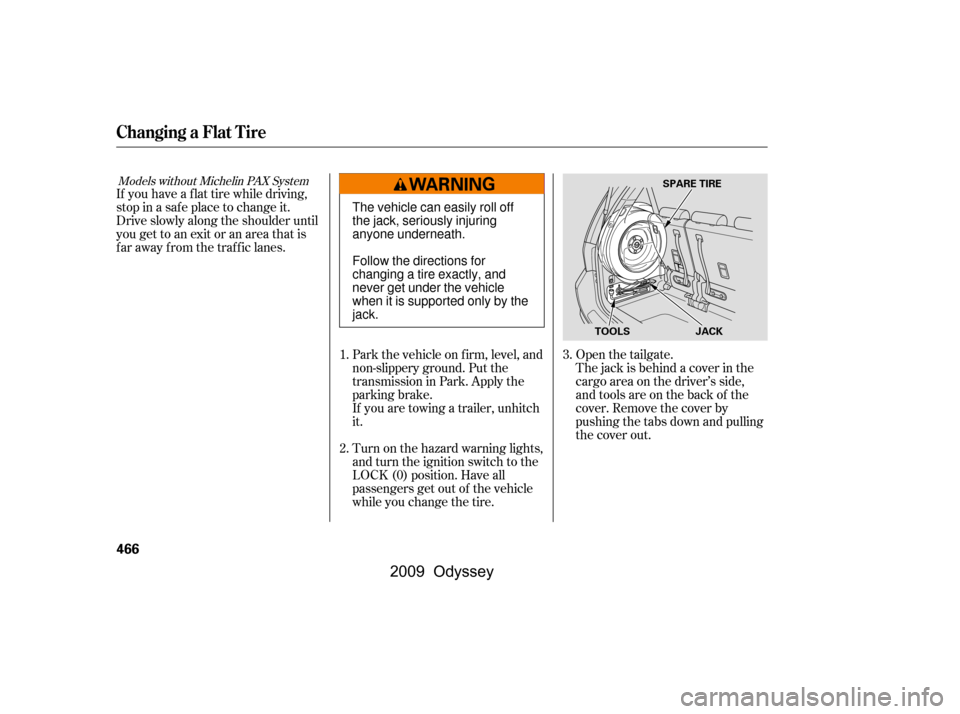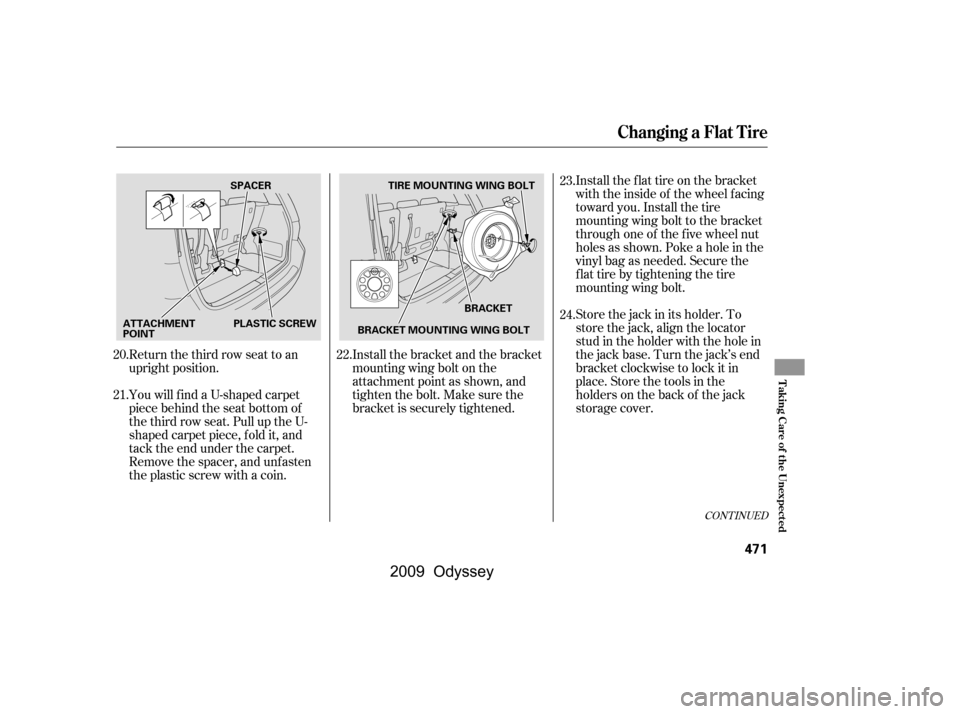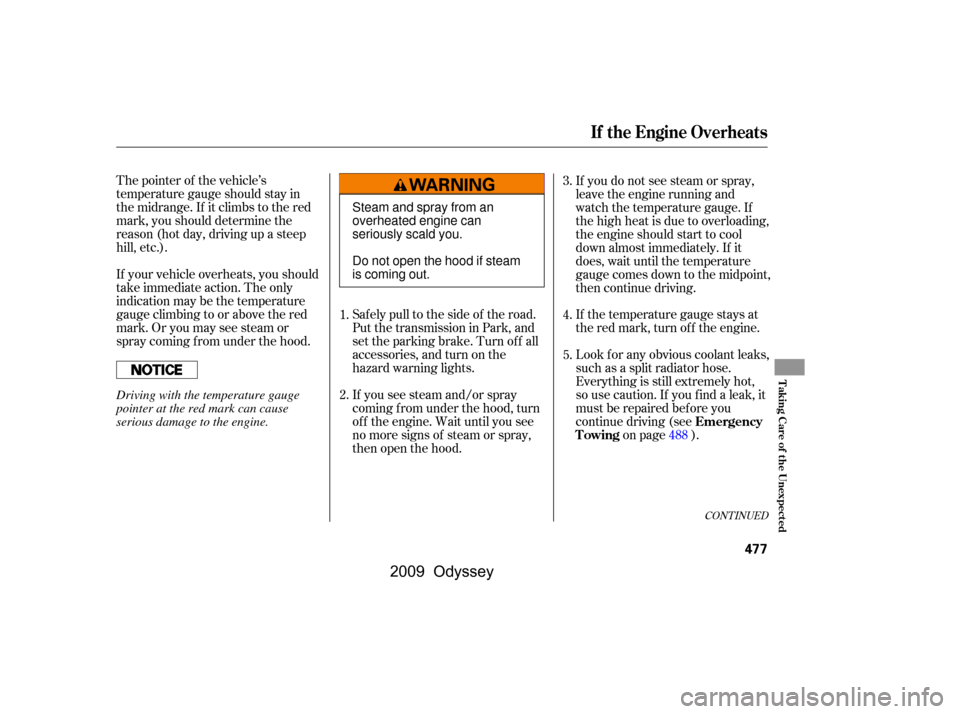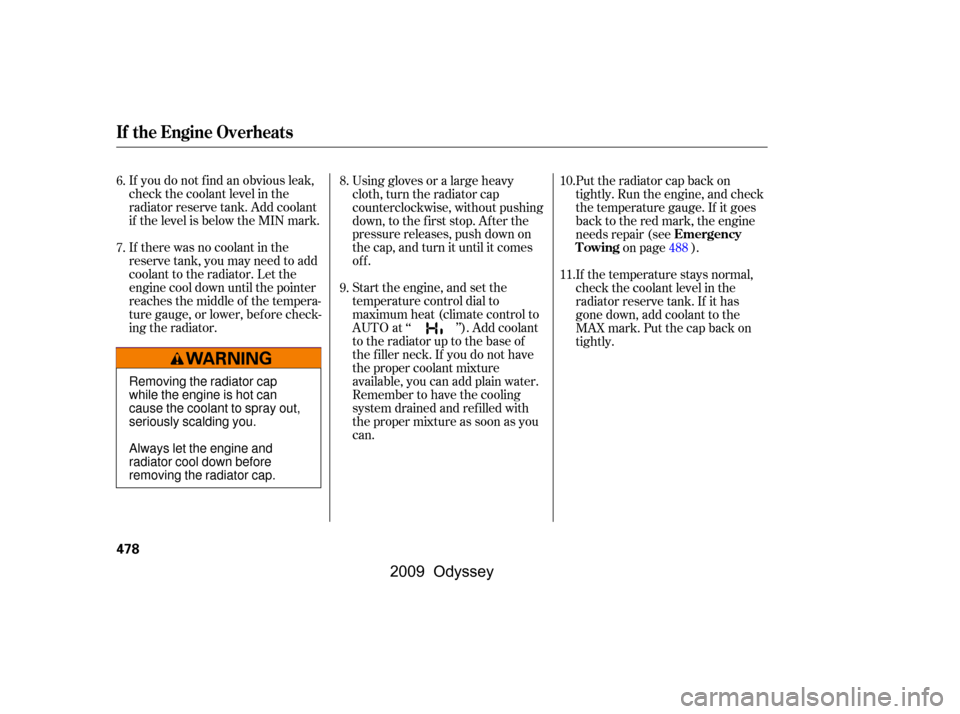Page 469 of 532

The jack is behind a cover in the
cargo area on the driver’s side,
and tools are on the back of the
cover. Remove the cover by
pushing the tabs down and pulling
the cover out.
Open the tailgate.
If you have a f lat tire while driving,
stop in a saf e place to change it.
Drive slowly along the shoulder until
you get to an exit or an area that is
far away from the traffic lanes.
Park the vehicle on f irm, level, and
non-slippery ground. Put the
transmission in Park. Apply the
parking brake.
If you are towing a trailer, unhitch
it.
Turn on the hazard warning lights,
and turn the ignition switch to the
LOCK (0) position. Have all
passengers get out of the vehicle
while you change the tire.
2.
1.3.
Models without Michelin PAX System
Changing a Flat Tire
466
JACK
SPARE TIRE
TOOLS
The vehicle can easily roll off
the jack, seriously injuring
anyone underneath.
Follow the directions for
changing a tire exactly, and
never get under the vehicle
when it is supported only by the
jack.
�����—�����—���
�y�
����
��������y���
�(�����������y�������
�y
2009 Odyssey
Page 474 of 532

CONT INUED
Install the bracket and the bracket
mountingwingboltonthe
attachment point as shown, and
tighten the bolt. Make sure the
bracket is securely tightened.Install the flat tire on the bracket
with the inside of the wheel facing
toward you. Install the tire
mounting wing bolt to the bracket
through one of the f ive wheel nut
holes as shown. Poke a hole in the
vinyl bag as needed. Secure the
f lat tire by tightening the tire
mounting wing bolt.
Store the jack in its holder. To
store the jack, align the locator
stud in the holder with the hole in
the jack base. Turn the jack’s end
bracket clockwise to lock it in
place. Store the tools in the
holders on the back of the jack
storage cover.
Return the third row seat to an
upright position.
YouwillfindaU-shapedcarpet
piece behind the seat bottom of
the third row seat. Pull up the U-
shaped carpet piece, f old it, and
tack the end under the carpet.
Remove the spacer, and unfasten
the plastic screw with a coin.
20.
21.
22.23.
24.
Changing a Flat Tire
T aking Care of t he Unexpect ed
471
BRACKET
TIRE MOUNTING WING BOLT
SPACER
PLASTIC SCREW BRACKET MOUNTING WING BOLT
ATTACHMENT
POINT
�\f���—�\f���—���
�y�
����
��������y���
�(���������\f�y�\f�������y
2009 Odyssey
Page 477 of 532
If youfindnothingwrong,youwill
need a qualif ied technician to f ind
the problem. Seeon page .
Are you using a properly coded
key? An improperly coded key will
cause the immobilizer system
indicator in the instrument panel
to blink rapidly (see page ).
There may be an electrical
problem, such as no power to the
f uel pump. Check all the f uses
(see page ).
In this case, the starter motor’s
speed sounds normal, or even f aster
than normal, when you turn the
ignition switch to the START (III)
position, but the engine does not run.
Do you have f uel? Check the f uel
gauge; the low f uel indicator may
not be working.
Are you using the proper starting
procedure? Ref er to
on page . 143
385 483 488
Emergency
Towing
T he Starter Operates Normally
Starting the
Engine
If theEngineWon’tStart
474
�\f���—�\f���—���
�y�
����
������
�y���
�(���������\f�y�\f�������y
2009 Odyssey
Page 480 of 532

The pointer of the vehicle’s
temperature gauge should stay in
the midrange. If it climbs to the red
mark, you should determine the
reason (hot day, driving up a steep
hill, etc.).
If your vehicle overheats, you should
take immediate action. The only
indication may be the temperature
gauge climbing to or above the red
mark. Or you may see steam or
spray coming f rom under the hood.
If you see steam and/or spray
coming f rom under the hood, turn
of f the engine. Wait until you see
no more signs of steam or spray,
then open the hood.
If the temperature gauge stays at
the red mark, turn off the engine.
Saf ely pull to the side of the road.
Put the transmission in Park, and
set the parking brake. Turn of f all
accessories, and turn on the
hazard warning lights.
If you do not see steam or spray,
leave the engine running and
watch the temperature gauge. If
the high heat is due to overloading,
the engine should start to cool
down almost immediately. If it
does, wait until the temperature
gauge comes down to the midpoint,
then continue driving.
Look f or any obvious coolant leaks,
such as a split radiator hose.
Everything is still extremely hot,
so use caution. If you f ind a leak, it
must be repaired bef ore you
continue driving (see
on page ).
1.
2.
3.
4.
5.
488
CONT INUED
If theEngineOverheats
Emergency
Towing
T aking Care of t he Unexpect ed
477
Steam and spray from an
overheated engine can
seriously scald you.
Do not open the hood if steam
is coming out.
Driving with the temperature gauge
pointer at the red mark can cause
serious damage to the engine.
�����—�����—���
�y�
����
����
���y���
�(�����������y���������y
2009 Odyssey
Page 481 of 532

If you do not f ind an obvious leak,
check the coolant level in the
radiator reserve tank. Add coolant
if the level is below the MIN mark.
If there was no coolant in the
reserve tank, you may need to add
coolant to the radiator. Let the
engine cool down until the pointer
reaches the middle of the tempera-
ture gauge, or lower, bef ore check-
ing the radiator.
Using gloves or a large heavy
cloth, turn the radiator cap
counterclockwise, without pushing
down, to the f irst stop. Af ter the
pressure releases, push down on
the cap, and turn it until it comes
off.
Start the engine, and set the
temperature control dial to
maximum heat (climate control to
AUTO at ‘‘ ’’). Add coolant
to the radiator up to the base of
the f iller neck. If you do not have
the proper coolant mixture
available, you can add plain water.
Remember to have the cooling
system drained and ref illed with
the proper mixture as soon as you
can.
Put the radiator cap back on
tightly. Run the engine, and check
the temperature gauge. If it goes
back to the red mark, the engine
needs repair (see
on page ).
If the temperature stays normal,
check the coolant level in the
radiator reserve tank. If it has
gone down, add coolant to the
MAX mark. Put the cap back on
tightly.
6.
7.
8.
9.
10.
11.
488
If theEngineOverheats
Emergency
Towing
478
Removing the radiator cap
while the engine is hot can
cause the coolant to spray out,
seriously scalding you.
Always let the engine and
radiator cool down before
removing the radiator cap.
�����—�����—���
�y�
����
��������y���
�(�����������y���������y
2009 Odyssey
Page 484 of 532

The brake system
indicator normally
comesonwhenyou
turn the ignition switch to the ON
(II) position, and as a reminder to
check the parking brake. It will stay
on if you do not f ully release the
parking brake.
If the brake system indicator comes
on while driving, the brake f luid level
is probably low. Press lightly on the
brake pedal to see if it f eels normal.
If it does, check the brake f luid level
thenexttimeyoustopataservice
station (see page ). Slow down by shif ting to a lower
gear, and pull to the side of the road
when it is saf e. Because of the long
distance needed to stop, it is
hazardous to drive the vehicle. You
should have it towed and repaired as
soon as possible (see
on page ).
If the f luid level is low, take your
vehicle to a dealer, and have the
brake system inspected f or leaks or
worn brake pads.
However, if the brake pedal does not
f eel normal, you should take
immediate action. A problem in one
part of the system’s dual circuit
design will still give you braking at
two wheels. You will f eel the brake
pedal go down much f arther bef ore
the vehicle begins to slow down, and
you will have to press harder on the
pedal.
If the ABS indicator and the VSA
indicator come on with the brake
system indicator, have the vehicle
inspected by your dealer
immediately.
If you must drive the vehicle a short
distance in this condition, drive
slowly and caref ully.
You will also see a ‘‘CHECK BRAKE
SYSTEM’’ message on the multi-
inf ormation display (see page ).
You will also see a ‘‘BRAKE FLUID
LOW’’ message on the multi-
inf ormation display (see page ).
88 88
435 488
On Touring models
On Touring models
Brake System Indicator
Emergency
Towing
T aking Care of t he Unexpect ed
481
U.S. Canada
�\f���—�\f���—���
�y�
����
������
�y���
�(���������\f�y�\f�������y
2009 Odyssey
Page 491 of 532

�µ�µ
If your vehicle needs to be towed,
call a prof essional towing service or
organization. Never tow your vehicle
with just a rope or chain. It is very
dangerous.
Therearetwowaystotowyour
vehicle:
With the f ront wheels on the ground,
it is best to tow the vehicle no farther
than 50 miles (80 km), and keep the
speedbelow35mph(55km/h).
The operator
loads your vehicle on the back of a
truck. The tow
truck uses two pivoting arms that go
under the tires and lif t them of f the
ground. The f lat tire side (f ront or
rear)shouldbeliftedbythewheel-
lift equipment. The other two tires
remain on the ground.
If , due to damage, your vehicle must
be towed with the f ront wheels on
the ground, do this:
Start the engine.
Press on the brake pedal. Move
the shif t lever through all its
positions.
Shif t to D position f or 5 seconds,
then to N.
Turn of f the engine.
Release the parking brake.
Leave the ignition switch in the
ACCESSORY (I) position so the
steering wheel does not lock.Flat -bed Equipment Wheel-lif t Equipment
T his is the best way to
transport your vehicle. T his is an
acceptable way to tow your
vehicle.
Emergency Towing
488
Improper towing preparation will
damage the transmission. Follow the
above procedure exactly. If you cannot
shif t the transmission or start the
engine, your vehicle must be
transported with the f ront wheels of f
the ground.
�\f���—�\f���—���
�y�
������\f������y���
�(���������\f�y�\f�������y
2009 Odyssey
Page 492 of 532
Emergency Towing
T aking Care of t he Unexpect ed
489
Trying to lif t or tow your vehicle by the
bumpers will cause serious damage.
The bumpers are not designed to
support the vehicle’s weight.
The steering system can be damaged if
the steering wheel is locked. Leave the
ignition switch in the ACCESSORY (I)
position, and make sure the steering
wheel turns f reely bef ore you begin
towing.
�\f���—�\f���—���
�y�
������\f������y���
�(���������\f�y�\f�������y
2009 Odyssey